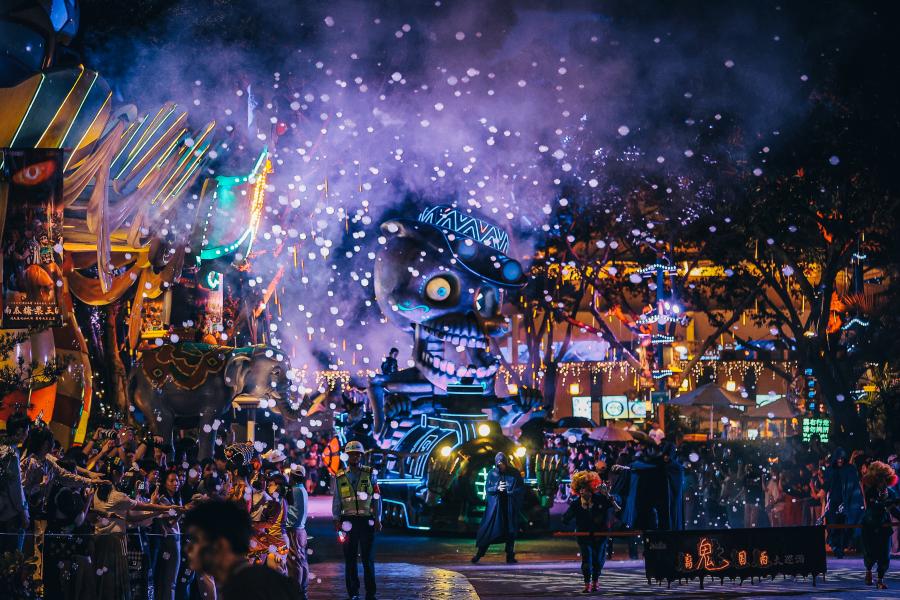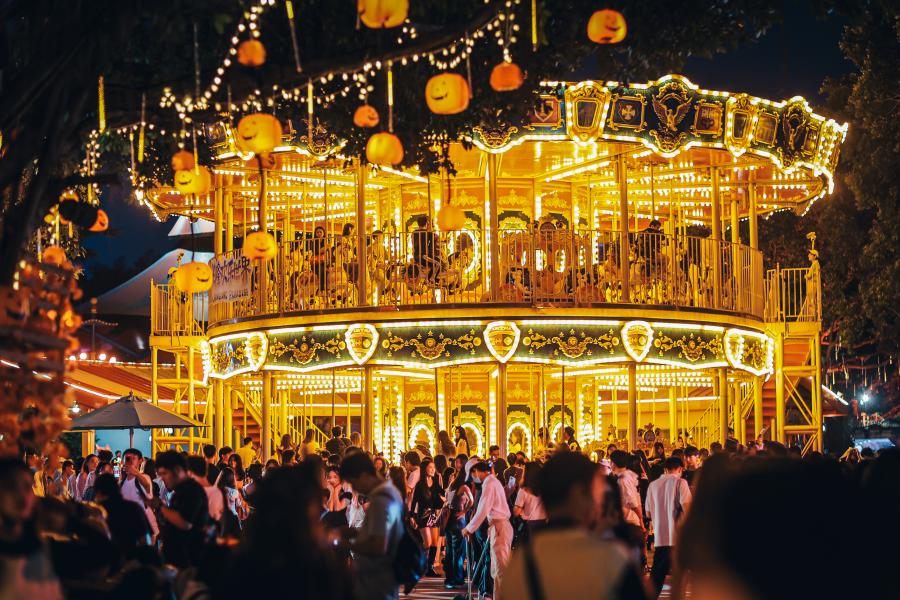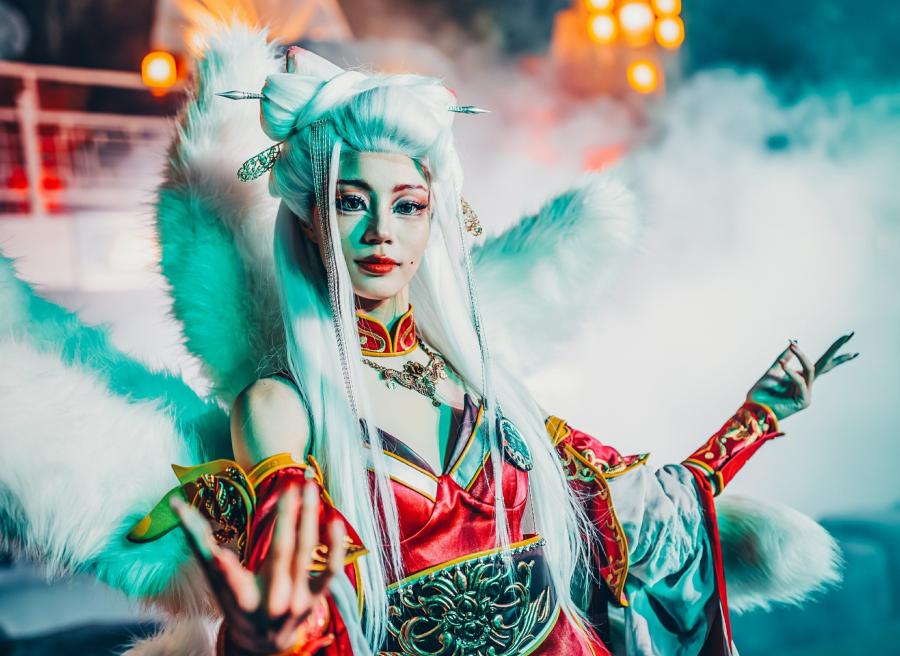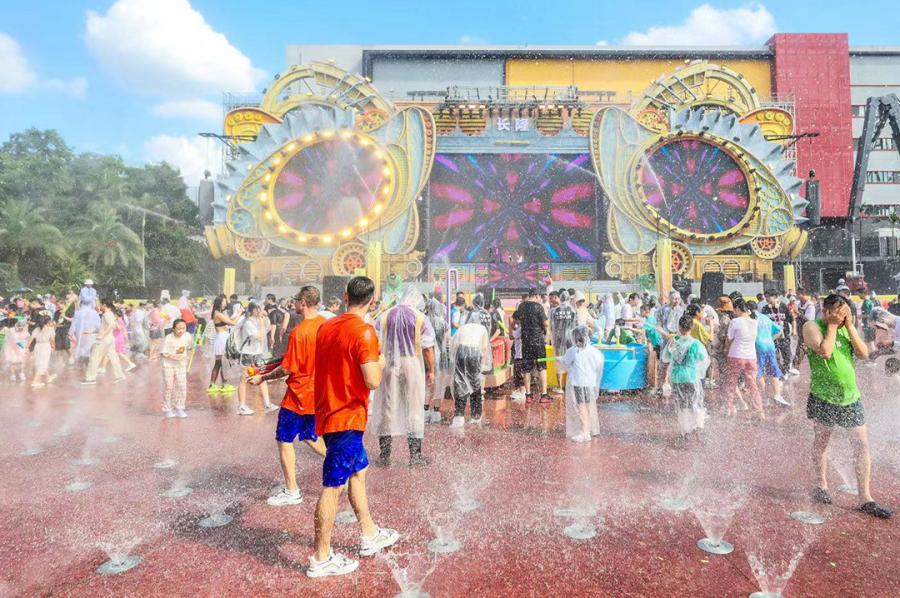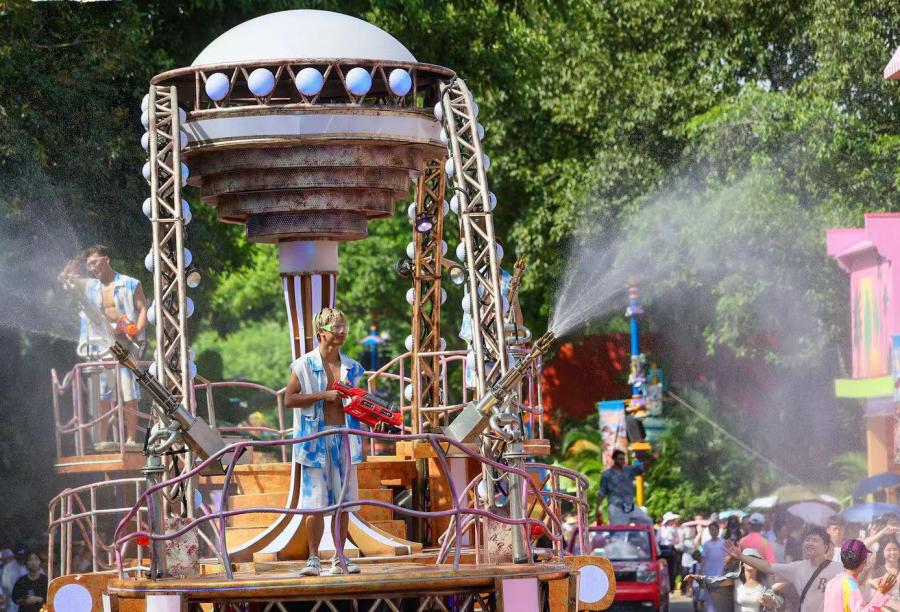As a roller coaster inversion twists in the background, a silent Chinese ghost adorned with an ornate blue and gold imperial headdress quizzes two young women at Chimelong Paradise in Guangzhou, China. Satisfied with their replies, the ghost places talismans on their heads—a centuries-old Taoist tradition to protect villagers from reanimated corpses. Later that night, on a round stage painted with eyes looking skyward, a trio of flame throwers dance and twirl amidst strobe lights, against the backdrop of a larger-than-life cyber-skeleton.
Chimelong Paradise’s monthlong Halloween festival is much more than a collection of haunted houses, though they are popular as well. It is a massive celebration, with concerts, live performances, and ecstatic fans. Nearly 1 million people visited Chimelong Paradise during the 29-day Halloween bash in 2023. Ticket sales surpassed pre-pandemic levels, exceeding the 2019 watermark by 8%.
The Halloween spectacle is the biggest production of the year at Chimelong—with a budget of approximately $3 million, which is about 10 times greater than its other seasonal activities. However, Chimelong also runs other special events across multiple parks, nearly year-round, to generate excitement, attract visitors, and remain relevant.
“Chimelong Paradise is an 18-year-old park. It has a roller coaster and no IP (intellectual property) themes in the original design, so we stage a lot of themed events to make it more interesting for guests to visit the park,” says Chimelong Vice General Manager of Entertainment Hans Lau, who oversees special events in four parks and three hotels in Guangzhou as well as a new forest resort that is scheduled to open later this year in Qingyuan, which is more than an hour north of Chimelong Paradise.
“We need to create talking points,” agrees Raymond Lin, who leads entertainment for Chimelong’s Zhuhai properties. “Chimelong Ocean Park is almost 10 years old. If there are no special events and just the normal routine, no one will bother to come back again.”
Almost a dozen special events are on the calendar at Chimelong Ocean Kingdom this year, including a Pampering Festival focused on beauty, a polar carnival to celebrate Christmas, and a three-night New Year’s Eve celebration. Lin often locates performances in less-trafficked areas of the park to spread guests out. His team also runs personalized experiences, such as the underwater wedding proposals from inside Ocean Kingdom’s massive aquarium that are popular with young couples.
Planning for Safety
Back in Guangzhou, the Halloween experience begins before guests enter the park. At the subway station and in the resort’s parking lot, Chimelong staff offer stickers and face painting for arriving guests. Pumpkin and skeleton stickers are free; more intricate designs cost as much as 298 yuan. Staff also provide cosmetic removal services because local regulations prohibit riding the train with scary makeup.
On some days during the Halloween season, as many as 70,000 people visit Chimelong Paradise, necessitating additional safety measures and special operating procedures. The park’s 700 performers undergo weeks of training to learn their roles as well as safety and emergency procedures. Every member of the team learns how to use a fire extinguisher, how to de-escalate a violent situation, and where it may be unsafe to charge cell phones due to the risk of circuit overloads. More than 400 staff members—including wardrobe, show directors, and haunted house operators—are also taught emergency procedures relevant to their position.
On crowded days, perhaps the biggest operational change is that guests can only proceed in one direction; they are not permitted to turn back or skip between the festival’s six zones. Cast members continue to engage with visitors on the side of the busy street, but they can also lead them to quieter areas to finish the interaction. Additionally, while cast members may gather guests in a circle on the street to teach them a dance or play a game on normal days, when the park is crowded, “Plan C” goes into effect—meaning that interactions are limited to one photo or a single sentence before performers move on to engage other guests.
Market Research
The vast majority of Chimelong’s guests are teenagers. The team planning the event schedule, unsurprisingly, falls outside this core demographic.
“I’m over 40,” Lau jokes, “so I cannot fully trust myself.”
Recognizing this age gap, Lau takes core members of his team into the field, where market research becomes the key to ensuring that Chimelong’s special events remain relevant.
“We visit a lot of different entertainment experiences—coffee shops, night clubs, concerts, shopping centers—from industries outside the attractions space, but with the same target group of customers,” Lau explains.
Themed cafés, for instance, are particularly popular in Guangzhou. Among trendy spots are a Korean chain called Zoo Coffee decorated with zebra stripes and plush toys, a Central Perk coffee house straight out of the TV show “Friends,” and a dim sum café named Highway Wang that serves osmanthus lattes and features a bright orange Jeep with a Michelin Man strapped in behind the steering wheel.
Lau and his team frequent the cafés to observe which ones resonate best with teens. Similarly, they study the music that fuels teen dance moves, the games that captivate them, the products that fill their shopping bags, and topics that ignite their conversations. In each case, the key question is, “Why? Why is this destination or product popular?”
For these answers, Lau turns to focus groups. He does not have to engage a public relations firm, though. Instead, he turns to Chimelong’s performers, most of whom are between the ages of 18 and 22, for this research.
“We ask them to share their ideas, what they enjoy and why,” he says. “They don’t have to make a report or prepare a proposal. They can just speak casually about their ideas.”
The goal is not to copy what’s hot but rather to explore the forces that are driving trends.
“The reason why it’s popular is more important than the product itself,” he explains.
Lau shares an example from a Xi’an attraction called The City of the Tang Dynasty that went viral on social media.
“It wasn’t a big production—just two guys with master’s degrees dressed as eighth-century scholars, inviting guests onto a stage with a simple backdrop and asking them questions about the region’s history and culture.
“It became incredibly popular, so much so that senior management suggested we have a similar type of Q&A performance on stage at Chimelong. But I felt it wouldn’t translate well to Guangzhou—our history isn’t as rich as Xi’an’s—so I convened my team to understand why the Tang Dynasty show was doing so well.”
After researching and several meetings, Lau’s team arrived at a conclusion: The competitive element, which tested guests’ knowledge, appealed to teens who wanted to impress their partners.
“They want to show off,” says Lau, who applied this realization inside a new themed zone during Chimelong’s Halloween celebration. Cast members dressed in the style of Old Guangzhou and Old Hong Kong challenge guests to complete a mission, often by answering questions about traditional melodies, culture, and characters. As in Xi’an, Chimelong’s guests have an opportunity to show off their knowledge—but within a context that is locally relevant.
Flexibility Is Key
Before Lau joined Chimelong, he worked at an attraction that began preparing for special events nearly a year in advance. He argues, however, that extended time frames are no longer feasible in an era of rapidly changing consumer preferences.
“Maybe 10 years ago we could do that, but not now,” he reflects. “We should not plan ahead too early. We have to ensure that we stay on top of consumer preferences as they can shift quickly.”
Chimelong’s special events teams begin preparing for an event six months in advance, but proposals are hardly set in stone. For the next three months, event concepts can undergo significant change, particularly in the areas of guest interaction and show experience. Characters can even be dropped or added. Set designs and decorations, though, are less likely to be modified once approved.
As an event approaches, even the day before, Lau and his team will make changes if they notice that a video, song, or meme has become popular on social media.
In resorts where intellectual properties are integral to an event, brand guidelines and lengthy approval processes may render this degree of flexibility difficult to achieve. Lau believes that this agility is a key differentiator for Chimelong.
“We do not have the biggest budgets or popular IPs,” Lau acknowledges, “but we also do not have to go through a lot of red tape. We embrace change, even at the eleventh hour, and I think this is one of the reasons that Chimelong’s special events are quite successful in China.”
Creating Effective Promotions
Chimelong’s marketing team begins work on publicity campaigns, including package deals with the resorts’ hotels, six to eight months in advance. Promotions often feature fun, professionally produced videos for television and online broadcast, which complement more traditional marketing channels like outdoor ads. User-generated content plays a key role as well.
“In the age of social media, there is no more economical and effective means of promotion than to maximize the sharing desire of tourists with high-quality products and themed packages, so that every tourist who comes to play becomes a brand spokesperson,” explains Chimelong Group Senior Counselor Tony Sze.
While creatives play a key role, at their heart, the marketing campaigns are data-driven, relying on a mix of internal information—like ticket sales and website traffic—and external data like industry trends, social media interaction, and competitor intelligence. After cleaning, integrating, and formatting the data, Chimelong arrives at user profiles, user behavior predictions, and sales forecasts.
With these profiles in hand, the marketing team articulates the promotion goals and strategies.
“The application of big data allows Chimelong’s marketing department to understand the target audience more accurately and formulate targeted promotional strategies,” says Sze. “At the same time, continuous optimization and adjustment of promotion strategies is key to ensure adaptation to the ever-changing market environment and user needs.”
Summertime Fun
Special events not only encourage repeat visitation, they often generate business during off-peak periods.
Summers, for instance, used to be an unpopular time to visit Chimelong Paradise. With temperatures regularly exceeding 100 F, guests preferred playing in Chimelong’s water park. If they did visit the amusement park, they rushed to its indoor 4D theater. To address the attendance slump, Lau introduced Summer Splash in 2021. He transformed the parade, adding bubble-makers and water cannons to the floats. Cast members with high-powered squirt guns take aim at poncho-wearing park-goers, many of whom have purchased their own water toys in the park and are replenishing them in fruity troughs that Chimelong has strategically placed along the route. Stage performers, dozens of misting jets, and cast members who instigate a conga line add to the festive atmosphere that’s performed three times a day.
At Chimelong Safari Park, home to more than 20,000 animals, including white tigers, black langurs, and a giant panda, Chimelong understands that the wildlife will always be the primary draw, yet special events still add another dimension to enhance the visitor experience.
Two years ago, Chimelong added an annual celebration to the safari park’s calendar. Chimelong hired nearly 70 performers from Kenya and other sub-Saharan countries to recreate an African village in the Guangzhou park, complete with drumming, interactive dancing, snacks, and ceremonies. In 2022, the impact on attendance was negligible, though this was still during the pandemic period. In 2023, ticket sales for the safari park tripled from the year earlier, recording 631,000 guests—which is also 20% above pre-pandemic attendance levels. This year, Chimelong is replacing the African village with a new concept to celebrate the 10th birthday of the park’s panda. A Panda Village, with animation, a “panda catwalk,” bamboo instruments, and images of other animals who will attend the panda’s birthday party are all featured.
- This original reporting from IAAPA News first appeared in Funworld magazine. For more stories and videos covering the global attractions industry and to read a digital version of Funworld magazine, click here.

